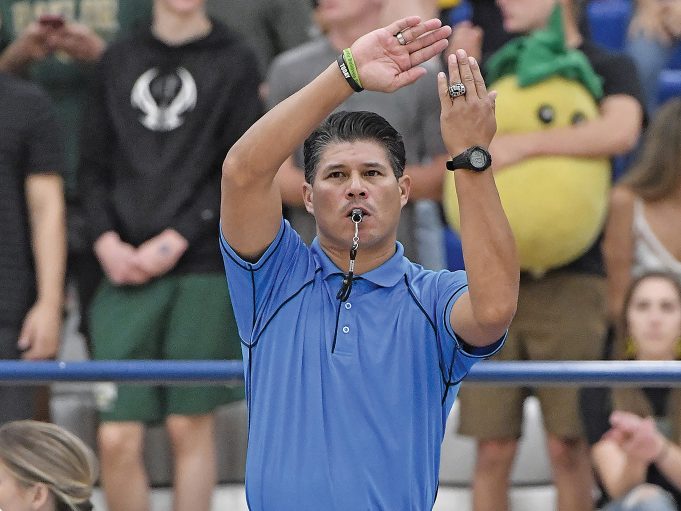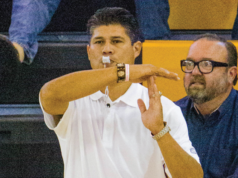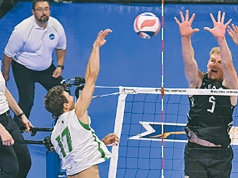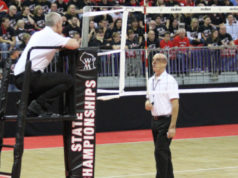Communication between first and second referees is essential in communicating decisions to players, coaches, assistant officials and spectators. Precisely executed, established signals indicate the referees are competent and in control of the match. Formal signals are exhibited “big” to communicate with all match participants and spectators, whereas discreet, informal signals are usually “little” and are used for communication between the officiating crew.
All three rulesmaking bodies — NFHS, NCAA and USAV — have dedicated sections in the rulebook listing descriptions and pictorial examples of properly executed formal signals. Knowing when to use them and applying them correctly makes for a smooth match with few problems.
There are also several “informal” signals frequently used, especially by second referees to assist the first referee during the match, and are discussed in officials’ manuals for all three rule sets. There are times in a match, however, when informal signals need to be made more prominent, so the correct call can be made by the officiating team.
The first referee has final authority and maintains general supervisory control of the teams and other officials. He or she makes the final decision concerning matters not specifically covered by the rules or where there is a discrepancy between referees and line judges. However, the role of the second referee cannot be overlooked in assisting the first referee to administer the match.
It is important that a good prematch conference is held between all officials, especially the first and second referee, before the match, when discussing informal signals. Here is where you can determine when you want the R2 to go big on an informal signal. During this discussion, preferably away from the court in a locker room, the officials will discuss particulars of their roles and specifically informal signals used by both referees.
Informal signals include but are not limited to:
- Set/match point • Four hits
- Identifying possible back-row player violations (including the libero and all back-row players)
- Position of setter prior to serve • Illegal hits • Ready to play
- Net fault player identification
- Antenna fault team identification
- Out (identifying the team at fault)
Other informal signals may also include head nods (yes and no), identifying back-row player violations (by arm diagonally across midsection or pointing to attack line), illegal hits out of the view of the first referee (palm up and slightly raise arm or two fingers indicating double) and down balls, especially on pancakes. To indicate a fourth contact without an intervening block, the R1 may ask the R2 during the pre-match discussion to use four fingers on the opposite shoulder. The R1 may also ask the R2 to use a discreet touch signal in front of the chest to indicate the blocking team did, indeed, make a contact and negate the four-hits violation.
More referees tend to use the four hits signal versus the touch signal when working with line judges, who are primarily responsible for identifying touches. If there was a “touch” by the blocker(s), no signal would be shown. The general rule is, unless there is a violation, the R1 or R2 should not be signaling anything unless it is pertinent to the match in order to communicate with each other, players or coaches. Examples would be the R1 using the “legal back-row player contact” signal when the takeoff was behind the attack line or “ball below the height of the net” signal when a back-row setter sends the ball over the net legally.
It is important these signals be thoroughly discussed in the prematch conference between both referees. When the second referee uses a discreet, informal signal, it should be briefly held and limited to situations where the first referee might have difficulty viewing the play or is blocked. Different angles on a play present challenges and may contribute to different perspectives on what happened. Again, four eyes are better than two and both referees play an extremely vital role in administering the match.
One must also note if a second referee gives a discreet signal and the first referee disagrees with the “suggestion” (usually by a head shake indicating “no”), the second referee should drop the signal immediately. Most of the discreet signals (those that would interrupt play or change a decision for a point) are shown in front of the midsection of the R2 and are only used to communicate with the first referee. They are not accompanied by a whistle. The first referee has the option to accept the call suggested by the second referee.
All referees must understand under no circumstances should a second referee ever whistle a ballhandling violation. When a player’s back is to the first referee or the play is blocked by other players, the second referee should give a discreet, or perhaps not so discreet if egregious, illegal-hit signal (palm raised or double contract), but the choice to accept or deny is solely that of the first referee.
An exception is made with a backrow player fault. If the second referee is absolutely positive a fault has occurred, either an illegal attack or block, the first referee should be given a brief time and if the R1 does not whistle, it is permissible for the R2 to whistle, signal and wait to repeat the awarded point from the first referee for the violation.
One of the formal signals often misinterpreted by the R2 as being an informal signal is the touch signal. This is not meant to suggest the R2 signals a “touch” on every contact, especially if the ball remains in play. If the ball is out of play and the “touch” on a player would alter the point awarded to a particular team, the R2 should go “big” with his or her signal by stepping out sideways and slightly forward to get the attention of the first referee, and show the touch signal on the side of the offending team. This touch is not a discreet signal and should be shown to get the attention of the first referee.
All formal signals used by referees are exhibited “big” by both referees outside the “outline” of the body so that results/violations of play are understood by all match participants, assistant officials and spectators. Those signals are all shown “big” when interrupting play; informal signals are limited to discreet communication between the referees, while allowing the R1 to make the final decision on a violation of the rules.
Knowing the rules and roles of both referees, having good prematch (and post-match) discussion and knowing when and how to use discreet signals will contribute to a well-officiated match. Each referee should be familiar with all signals, know when and how to use them and communicate extensively before, during and after the match.
Marsha Goodwin North, Cleveland, Tenn., is an NCAA official, former USAV official and state supervisor of officials for the Tennessee Secondary School Athletic Association.
What's Your Call? Leave a Comment:
Note: This article is archival in nature. Rules, interpretations, mechanics, philosophies and other information may or may not be correct for the current year.
This article is the copyright of ©Referee Enterprises, Inc., and may not be republished in whole or in part online, in print or in any capacity without expressed written permission from Referee. The article is made available for educational use by individuals.


















